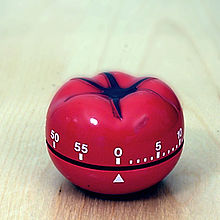I mentioned I’ve started using a Pomodoro timer to see if it helps me get more work done. When you don’t have a boss or clients or a set schedule, it’s easy to end your day and discover that you didn’t get that much done.
Using the timer keeps me focused on doing the work until it is done. Done might mean might mean finishing another group of tasks or another chapter, or it might mean completed a bunch of unrelated tasks.
While I’m working, if I have the urge to look at something online, I know it has to wait until the timer sounds and tells me it’s time for a break.
I ‘m also tracking my time reading and watching work-related videos. I give myself one Pomodoro (25 minutes) to do that each day. It’s how I keep my saw sharpened and my head (and Evernote) filled with ideas.
Anyway, so far, so good. I’m getting more work done and it feels good.
Doing this for the past few weeks has revealed some interesting things about how I use my time. Mostly, I’ve learned that some things take longer than I had thought. When I look at what I’ve done for the day or the week and compare that to how much time I spent doing it, I can see where I need to reconsider some of my priorities.
As I keep doing this, I will no doubt make some changes to my work flow. Some things will be allocated less time or eliminated, to make room for other things I’m not doing enough.
So here’s the thing.
If you’ve tried a Pomodoro timer in the past and stopped, as I did, try it again. There are a plethora of web apps and mobile apps you can use. Or find another way to track your time. If you bill hourly, start also tracking your non-billable time. If you don’t bill hourly, pretend you do.
You may gain some valuable insights into how you spend your day and identify some simple ways to improve your productivity and increase your income.
How I use Evernote to stay organized








